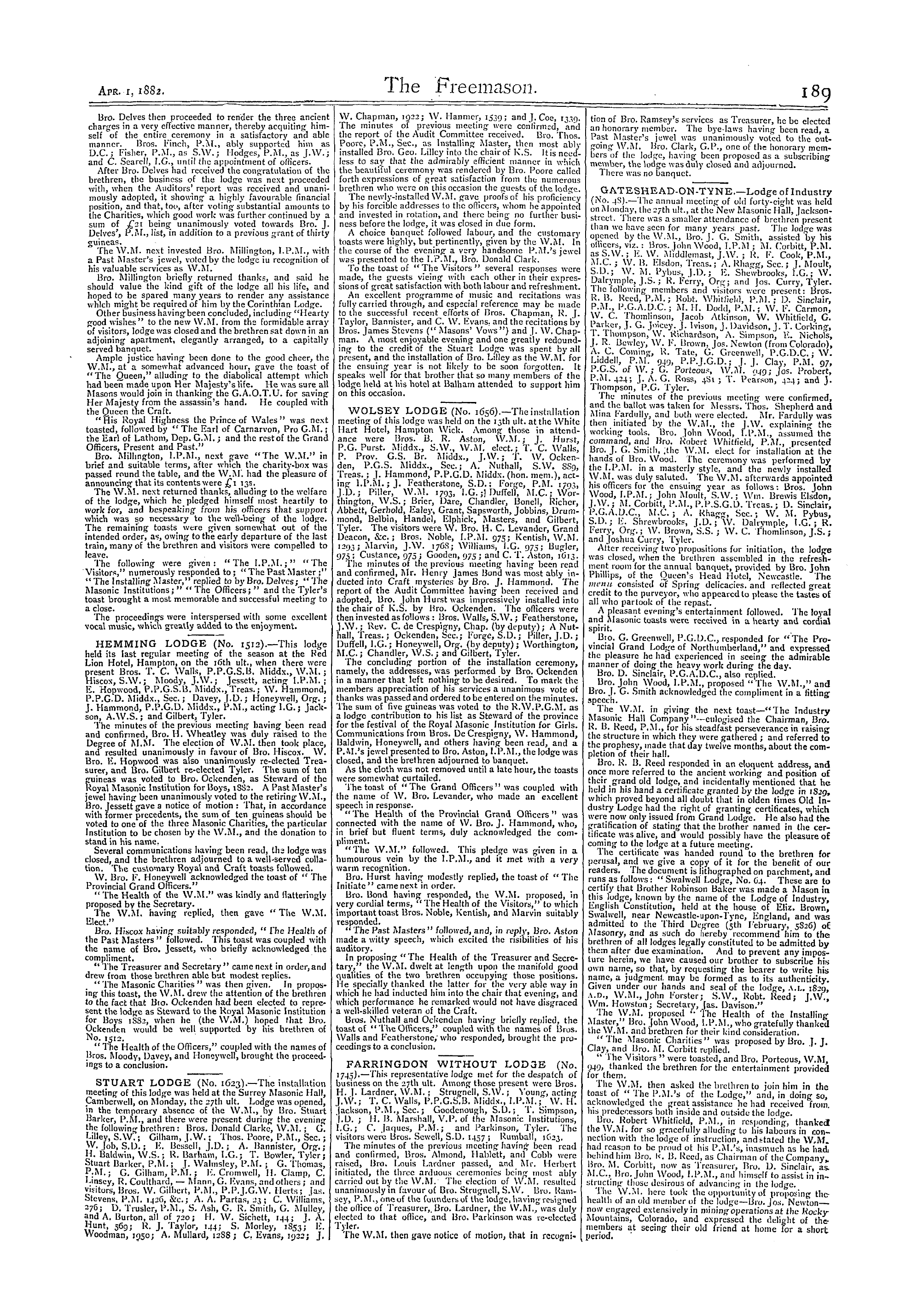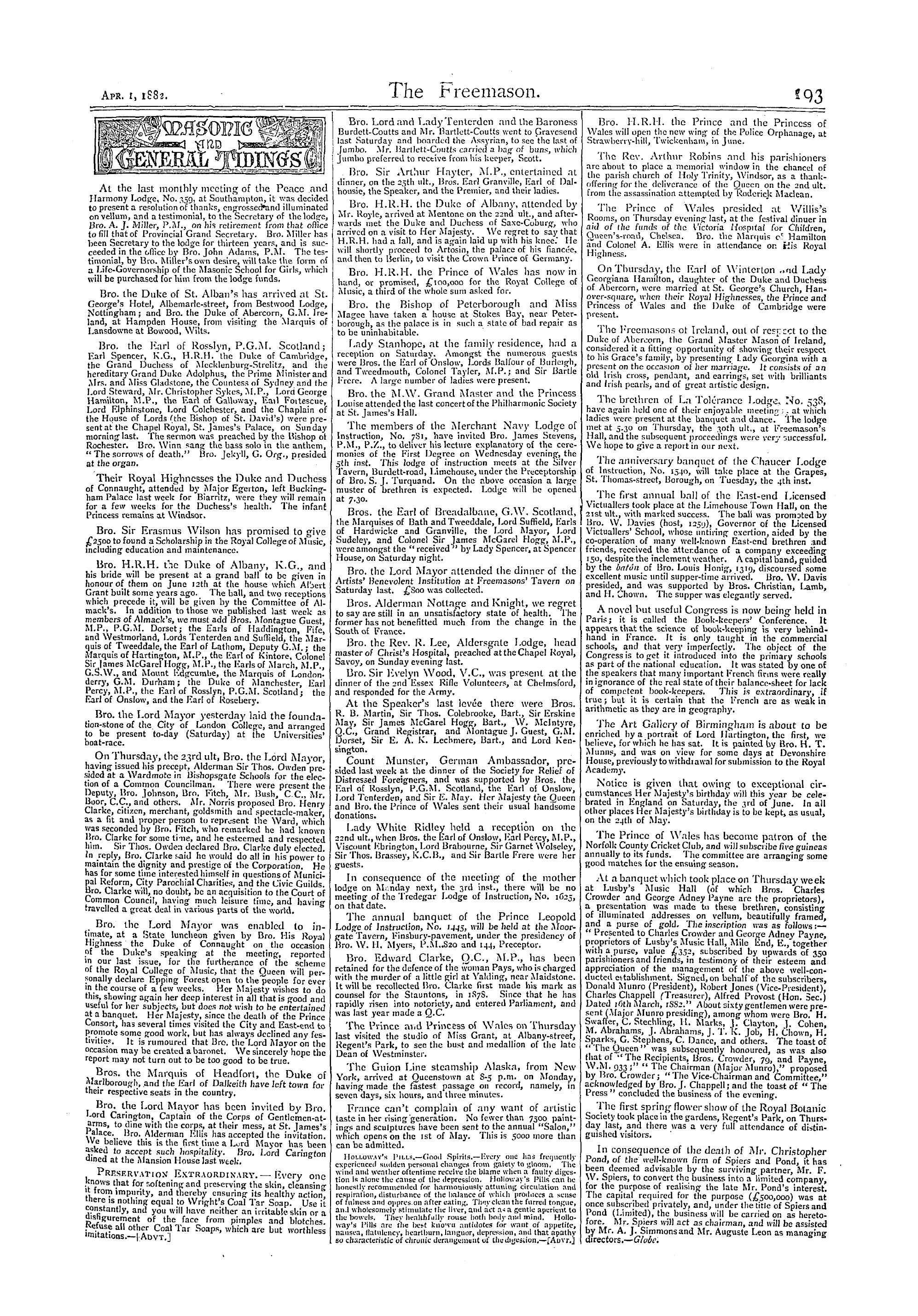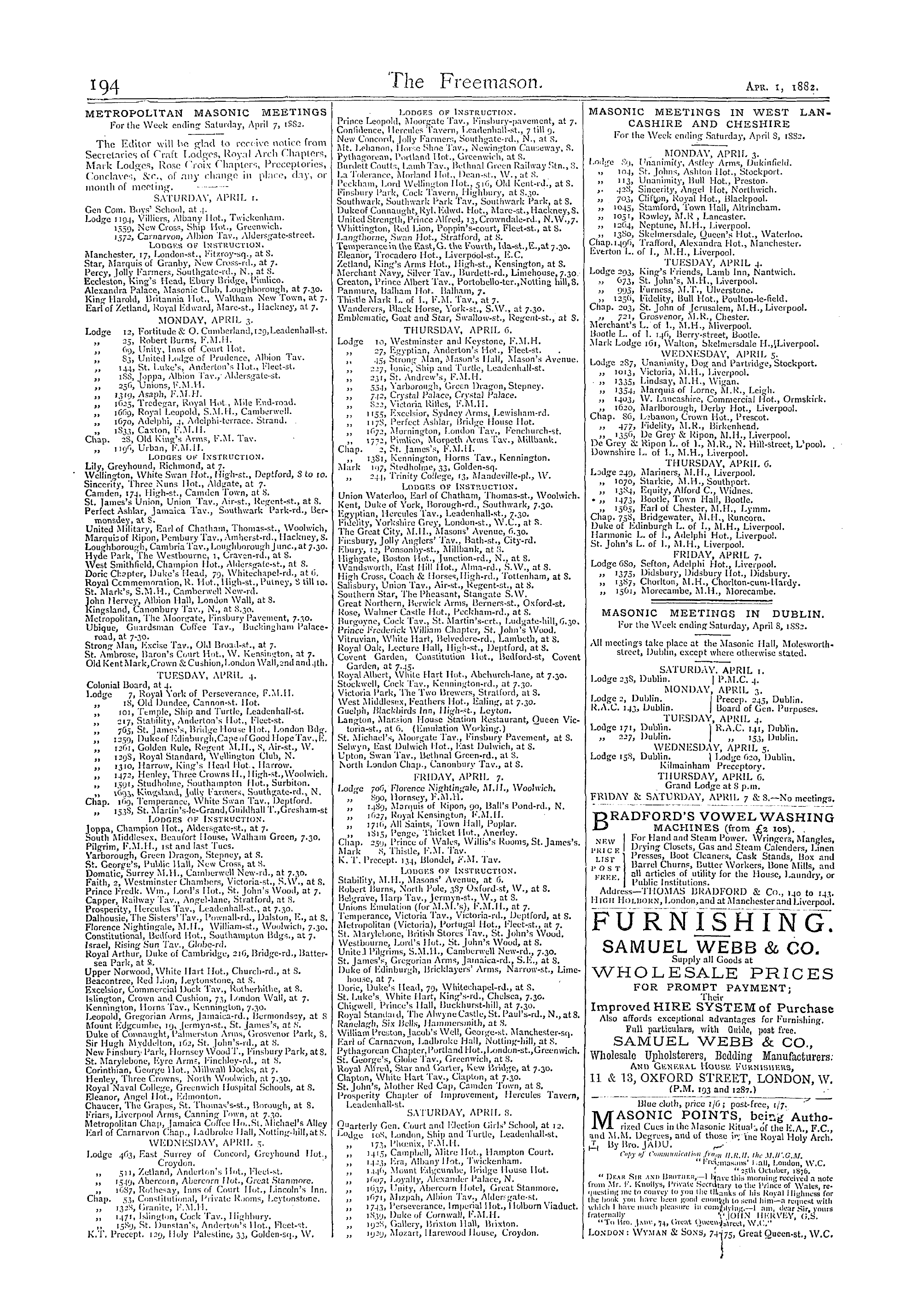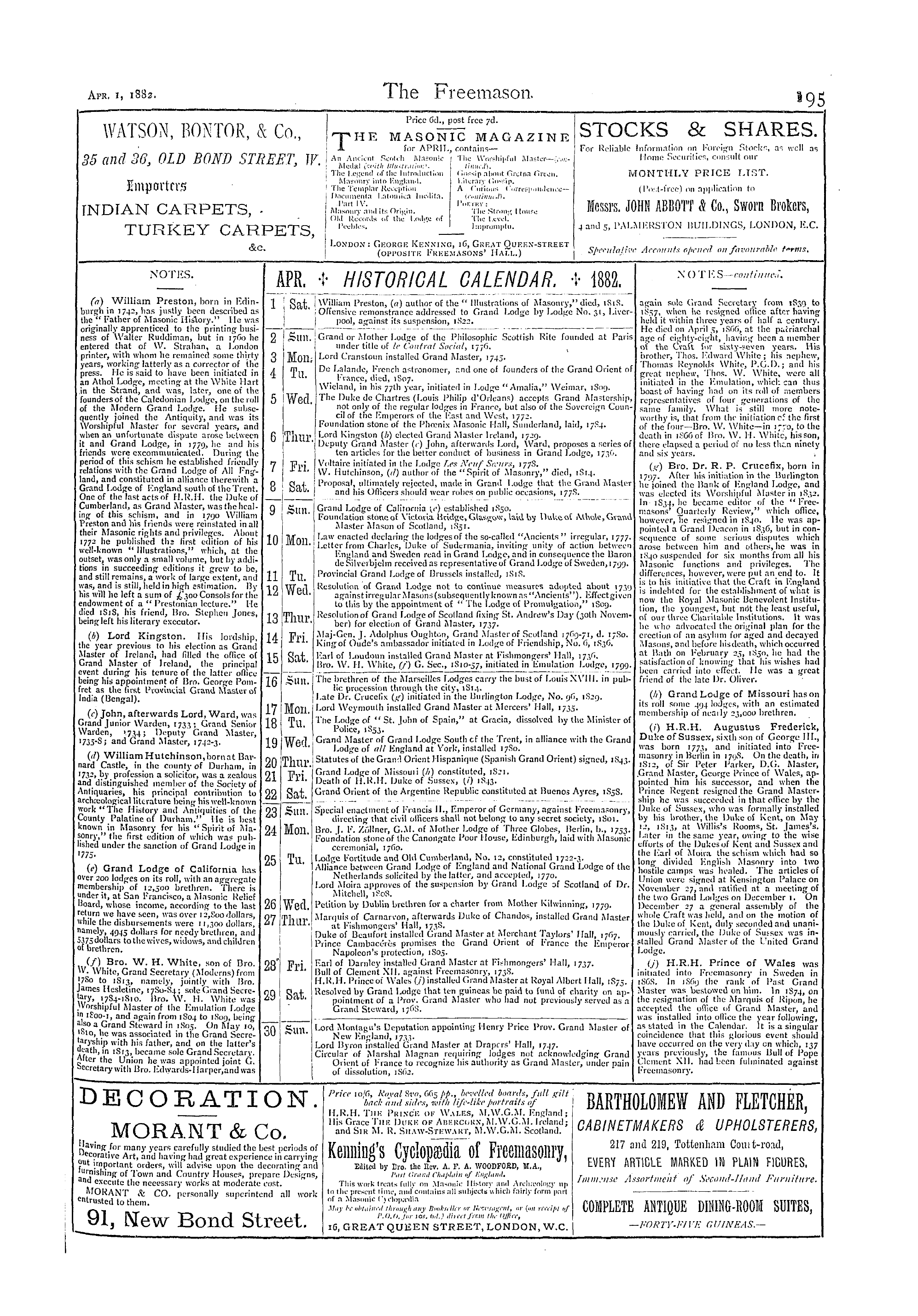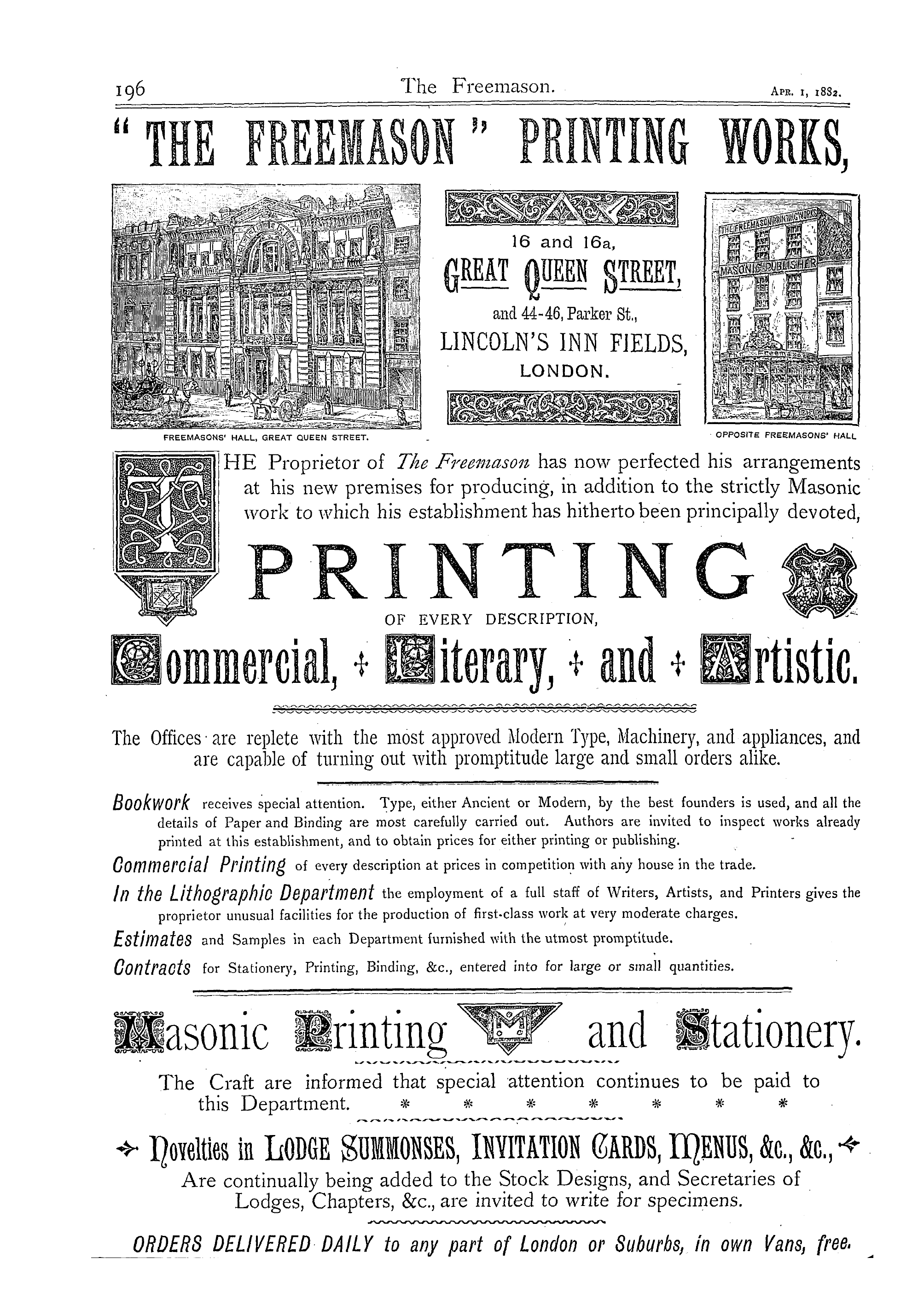-
Articles/Ads
Article MASONIC HISTORY AND HISTORIANS. Page 1 of 1 Article MASONIC HISTORY AND HISTORIANS. Page 1 of 1 Article CLANDESTINE MASONRY. Page 1 of 1
Note: This text has been automatically extracted via Optical Character Recognition (OCR) software.
Masonic History And Historians.
MASONIC HISTORY AND HISTORIANS .
HY MASONIC s'rrnr . NT . As Mr . lilton , in his " Origin of Fnglish History , " seems to doubt thc existence of Albanus , and to look upon his name as a mythic representation of heroic virtue , & c , 1 venture to call attention to the subject here . All our Masonic Gild Legends mention Albanus . In Lidgatc ' s poetic account of him ( a very long poem , by the way ) , Lansdowne MS . 699 , he
says—The knightly manny s name , Born in Verlameye , a famous gret cite , Knighted in Rome , ( the chronicle who list see ) And , as 1 fynde , this yong lusty man Took first the Ordre of Dioclician .
He then tells us he was sent by " Kyng Scverus , " with a young prince called Bassian , to Rome to Dioclecian , and with him went Amphibalus , by whom " Albon" was afterwards converted from heathenism to Christianity . He went to be knighted , Sec . At folio 9 8 of the Lansdowne MS . 6 99 , there come in two words , " Hxpt . Prologus , " Kxplicit Prologus , which seems to
point out that this long poem very probably belonged to a Gild , and was repeated or acted . Lidgate says that Amphibalus was a Prince's son of Wales , and thai Albanus was born in the cite of Verolamye , was of " genlil condicion , " of " the aspectes of grace which is divine , " of " this region the Prothomartyr , " " gracious in every manny ' s sight , " and " weel beloved , "
and was knighted by Dioclecian . He was , we are told , a Steward of Britain under the Romans . But I can find nowhere any allusion to Alban building Verulamium . Whence then did the Masonic Gild Legends obtain this
statement ? And lo whom of lhe Chroniclers docs Lidgate allude' / This life and passion of Scynt Albon and Seynt Amphibal was translated out of French and Latin (?) by Dan John Lidgate , at thc request of Maislre John Whetehamstcde , Abbot of Saynt Albons , the Grace of our Lord ,
MCCCCXXXIX . When Offa , in 793 , built the minster of St . Albans , with the "hond Macones , " as Lidgate calls them , he probably enlarged the church of which Bede speaks as existing in his life , and having been built in " peaceable times . " Bede died in 735 . He certainly , like OfTa , the King , and the later
chroniclers who mention him , treated him as a real personage , and Lidgate goes into a full description of his special merits and personal gifts , though whence he derives his authority he tells us not . His long poem is mainl y based on Bede's account in thc seventh chapter of his Ecclesiastical History . All our Masonic Legends mention Albanus , and they seem to have obtained
the term " High Steward " from Lidgate . Inigo Jones ' s MS . gives us a very full account which is practically the same , with slight changes of verbiage , in all the Gild Legends except thc Masonic poem and the additional MS . ( prose ) . " And in St . Albanes time , the King of England that was a Pagan , did wall ye town that was called Verulum , and St . Alban was a worth y
Knight and Steward of the Kings household , and got the government of ye realm , and also the town walls , and loved Masons well and cherished them much , and he made them pay right good , standing as the Realm then did , for it gave them two shillings per week , and threepence to their chear . For before that time through all lhe land a Mason had but a penny a
day and his meat , until until Saint Alban mended it . And he got them a charter of ye King for to hold a conned ! yearly , and gave it the name of an assembly , and was thereat himselfe , and helped to make Masons , and
gave them charges as you shall have afterwards . There is great confusion in Lidgates's narrative as lo the various pails played by Carausius the tyrant , Duke Ascopleodote , King Maximyan ; but Alban or Albanus is sent " into the . cylie by Dioclecian . "
Hothe for trust , ( pleynly to devise And to gov ' ne notably that lond , Pascell also ) , ( to gwerdon his sem ' se
Lor trouthe of Knyhthood ) in Albon that he fond , Or ordeyned hytn made surance with his hond , •Prynce of Knyhtis , and Steward Sovereyn L'niler Romayns , thoruli out al Hriteyn .
It is just possible that wc have in this story the fact of a Roman citizen , Proafectus Collegii , put to death for taking up a " nova superstitio , " who was in some way connected with the building sodalities of that time , —the Collegia Frabroruin or Opificum . Where thc early Gild Legends , however , get all these statements from , as I before remarked , is dillicult at present to say ; so far , I am not aw ire of any authority for them in the Chronicles .
It becomes then a matter of some importance to discover , if we can , whence the early Gild Legends obtained this peculiar statement of Albanus , to which from thc Lansdowne MS . they persistently adhere . Two points have often occurred lo me lately—( 1 . ) Is it the fact that we have the earliest printed work on Masonry in 1723 ; is there any chance of
an earlier printed work ? ( 2 . ) Are we quite sure that there is no Gild Legends between the additional MS . and the Lansdowne and Dowlands ? If you compare the Lansdowne , the two Sloane , the two Harleian , the Antiquity , the Alnwick , thc Hope , and the York MS ., & c , & c , you must come to the conclusion that they take their statement from some common
authority . What is that common authority ? Krausc ' s so-called York MS . adds , that Amfibalus was an architect , but the whole tenour of the other Gild Legends , as regards Albanus , is based on Lidgate . But then Lidgate says nothing about building the walls of Verulamium . How was that statement imported into the Legends ?
It seems to me that there has been some intermediate authority between the Masonic Poem and the additional MS ., and the later MSS ., both about 1425 , on \ yhich the subsequent Gild Legends are founded . lt may have been a real Gild Constitution , now
Masonic History And Historians.
forgotten ; or there may have been , about the end of the fifteenth or beginning of the sixteenth century , some small printed work , which has passed away , and so far eluded discovery . Such things will occur in literature . Take , for instance , Dassigny ' s pamphlet . So far the copy in the possession of Bro . Hughan is unique , though search has been made
everywhere for a duplicate ; and 1 am told on good authority that single copies of works and pamphlets have been printed . It has always struck medial the title-page of the Wood MS . is suggestive , inasmuch as there it is stated it is " neweley translated " by John Whytestones for John Sargensonne . It is
not impossible that that may refer lo a MS . ( 1610 ) , though it is not very common ; but it is still more likely to refer to a printed work . Indeed , the first page of the Wood MS . might make experts believe it was copied from a printed work . If so , what is il ? and where is it ?
Clandestine Masonry.
CLANDESTINE MASONRY .
A body of men who call themselves Masons , and who meet within the lines of an organization which they arc pleased to term a Masonic Lodge , not having any sufficient authority for such action , may justly be called clandestine . Whatever may be their system of association and government , whatever ritual they accept or the ceremony they enact , they do not repre .
sent a lawful and regular Masonry , lhe course they pursue may not involve any great moral turpitude , nevertheless it does not accord with the requirements that all genuine Craftsmen are pledged to obey . Perhaps it may bc said that there is no great harm in assuming the Masonic name and
conferring degrees upon willing candidates , even though the sanction of a proper authority is wanting . But why should sensible men care to play at being Masons ? Masquerading is all right enough in its place , but it hardly seems appropriate in connection with such matters as are made of chief importance in the Masonic system .
What is the object proposed by those who associate together and seek to maintain a society thus irregular and unauthorised ? If social good and pleasant fellowship constitute the ends desired , what need is there of borrowing the Masonic name ? If the leading motive be the desire to practice an attractive ceremonial , why not obtain a ritual which shall be as original as
possible , and stamp it with a title that shall not be misleading ? The men who establish clandestine lodges know very well that they cannot impart a genuine Masonry . It makes no difference as to the name they take , the ritual
they observe , the signs and words which they possess and teach , they have yet no power to " make Masons , " nor can they confer thc rights or benefits of a legitimate Masonry . Being outside the Fraternity themselves they have no power to' introduce others to those privileges which only regular Craftsmen
possess . Kvery now and then we hear of the formation of a clandestine lodge , that is of the association of a number of men who , without rightful authority ,
call themselves Masons and confer degrees . We wonder why it is that there is a disposition to engage in such business ; we wonder still more that intelligent men can be drawn into such associations if they have the desire to be instructed in a genuine Masonry and to profit by its teachings and
fellowship . The assuming of the . Masonic name , lhe imitating of its methods , and the practice of its rites and ceremonies , are not of themselves sufficient to create the lawful lodge . There must be authority given and recognizedauthority from a proper source—els 2 the association cannot be admitted to
the fellowship of those Bodies which of right bear thc Masonic name . If any choose to play with the system -to practice it in an irregular sort of way they may well be let alone to indulge their whim to the fullest extent .
Regular Brethren , however , can have nothing to do with such unlawful gatherings or work , nor can they' in any sense recognize anything purportino- lo be Masonry when thus clandestinely maintained and expressed . — Freemasons' Repository .
F . CLF . C . TK ; BUND ( F . ldektischer Bund ) . —A formation of German Freemasons at Wetzlar and Frankfort-on-lhe-Main , which sought after the Convent of Wilhelmsbad in 17 S 2 , and where the high grades were , so to say , running riot to " gradus ferre retrorsum " to the older and simpler grades of Craft Masonry . Why they took the name of " Eclectic" is not quite plain ,
as thc word is hardly appropriate , except that underlying this apparently reasonable movement were most probably some of the peculiar aims of the " Illuminati , " equally insidious as dangerous . It seems a little doubtful whether Von Knigge 01 " Von Dittfurth first broached the idea , and indeed it matters little ; but in 1783 , March 18 , the Prov . G . Lodge of
Frankfort-onthe-Main , S . F . Kustner , junior , being ils Secretary , and the Prov . Lodge "Joseph zum Reichs Adler" ( Wetzlar , March 21 , 1783 ) , W . Rett being Secretary , issued a joint address . This address was practically to the effect that the three symbolical grades were to be the " grundwerk " of the " Eclectic Bund , " but that each Lodge might preserve or use ( independently , however ,
of the system ) any of the high grades in vogue , or any degree of the Rite Kcossais . The practical effect of the movement was to bring back a great number of the Lodges to symbolical Masonry . In 17 S 9 a great festival was held , the Prov . Grand Mastcr Von Leonhardi presiding , at which Lodged from the following p laces were represented : Wetzlar , Aachen , Bentheim ,
Steinfurt , Briime , Kassel , Freiburg , Gotha , Hildesheim , Kaufbeeren , Neuwied , Rothenburg , Salsburg , Triest , Wiesbaden , Kempten , Altenburg , Krifeld , Ulm , Minister , Giesse , Rudolstadt , Karlsruhe , and five others not named , says the " Handbur . h . " In 1823 the Prov . Lodge of Frankfort took the name of " Grosse Loge des Eklcktischen Freimaurer Bundes , and such it still retains . —Kenning's Cyclopadin .
Note: This text has been automatically extracted via Optical Character Recognition (OCR) software.
Masonic History And Historians.
MASONIC HISTORY AND HISTORIANS .
HY MASONIC s'rrnr . NT . As Mr . lilton , in his " Origin of Fnglish History , " seems to doubt thc existence of Albanus , and to look upon his name as a mythic representation of heroic virtue , & c , 1 venture to call attention to the subject here . All our Masonic Gild Legends mention Albanus . In Lidgatc ' s poetic account of him ( a very long poem , by the way ) , Lansdowne MS . 699 , he
says—The knightly manny s name , Born in Verlameye , a famous gret cite , Knighted in Rome , ( the chronicle who list see ) And , as 1 fynde , this yong lusty man Took first the Ordre of Dioclician .
He then tells us he was sent by " Kyng Scverus , " with a young prince called Bassian , to Rome to Dioclecian , and with him went Amphibalus , by whom " Albon" was afterwards converted from heathenism to Christianity . He went to be knighted , Sec . At folio 9 8 of the Lansdowne MS . 6 99 , there come in two words , " Hxpt . Prologus , " Kxplicit Prologus , which seems to
point out that this long poem very probably belonged to a Gild , and was repeated or acted . Lidgate says that Amphibalus was a Prince's son of Wales , and thai Albanus was born in the cite of Verolamye , was of " genlil condicion , " of " the aspectes of grace which is divine , " of " this region the Prothomartyr , " " gracious in every manny ' s sight , " and " weel beloved , "
and was knighted by Dioclecian . He was , we are told , a Steward of Britain under the Romans . But I can find nowhere any allusion to Alban building Verulamium . Whence then did the Masonic Gild Legends obtain this
statement ? And lo whom of lhe Chroniclers docs Lidgate allude' / This life and passion of Scynt Albon and Seynt Amphibal was translated out of French and Latin (?) by Dan John Lidgate , at thc request of Maislre John Whetehamstcde , Abbot of Saynt Albons , the Grace of our Lord ,
MCCCCXXXIX . When Offa , in 793 , built the minster of St . Albans , with the "hond Macones , " as Lidgate calls them , he probably enlarged the church of which Bede speaks as existing in his life , and having been built in " peaceable times . " Bede died in 735 . He certainly , like OfTa , the King , and the later
chroniclers who mention him , treated him as a real personage , and Lidgate goes into a full description of his special merits and personal gifts , though whence he derives his authority he tells us not . His long poem is mainl y based on Bede's account in thc seventh chapter of his Ecclesiastical History . All our Masonic Legends mention Albanus , and they seem to have obtained
the term " High Steward " from Lidgate . Inigo Jones ' s MS . gives us a very full account which is practically the same , with slight changes of verbiage , in all the Gild Legends except thc Masonic poem and the additional MS . ( prose ) . " And in St . Albanes time , the King of England that was a Pagan , did wall ye town that was called Verulum , and St . Alban was a worth y
Knight and Steward of the Kings household , and got the government of ye realm , and also the town walls , and loved Masons well and cherished them much , and he made them pay right good , standing as the Realm then did , for it gave them two shillings per week , and threepence to their chear . For before that time through all lhe land a Mason had but a penny a
day and his meat , until until Saint Alban mended it . And he got them a charter of ye King for to hold a conned ! yearly , and gave it the name of an assembly , and was thereat himselfe , and helped to make Masons , and
gave them charges as you shall have afterwards . There is great confusion in Lidgates's narrative as lo the various pails played by Carausius the tyrant , Duke Ascopleodote , King Maximyan ; but Alban or Albanus is sent " into the . cylie by Dioclecian . "
Hothe for trust , ( pleynly to devise And to gov ' ne notably that lond , Pascell also ) , ( to gwerdon his sem ' se
Lor trouthe of Knyhthood ) in Albon that he fond , Or ordeyned hytn made surance with his hond , •Prynce of Knyhtis , and Steward Sovereyn L'niler Romayns , thoruli out al Hriteyn .
It is just possible that wc have in this story the fact of a Roman citizen , Proafectus Collegii , put to death for taking up a " nova superstitio , " who was in some way connected with the building sodalities of that time , —the Collegia Frabroruin or Opificum . Where thc early Gild Legends , however , get all these statements from , as I before remarked , is dillicult at present to say ; so far , I am not aw ire of any authority for them in the Chronicles .
It becomes then a matter of some importance to discover , if we can , whence the early Gild Legends obtained this peculiar statement of Albanus , to which from thc Lansdowne MS . they persistently adhere . Two points have often occurred lo me lately—( 1 . ) Is it the fact that we have the earliest printed work on Masonry in 1723 ; is there any chance of
an earlier printed work ? ( 2 . ) Are we quite sure that there is no Gild Legends between the additional MS . and the Lansdowne and Dowlands ? If you compare the Lansdowne , the two Sloane , the two Harleian , the Antiquity , the Alnwick , thc Hope , and the York MS ., & c , & c , you must come to the conclusion that they take their statement from some common
authority . What is that common authority ? Krausc ' s so-called York MS . adds , that Amfibalus was an architect , but the whole tenour of the other Gild Legends , as regards Albanus , is based on Lidgate . But then Lidgate says nothing about building the walls of Verulamium . How was that statement imported into the Legends ?
It seems to me that there has been some intermediate authority between the Masonic Poem and the additional MS ., and the later MSS ., both about 1425 , on \ yhich the subsequent Gild Legends are founded . lt may have been a real Gild Constitution , now
Masonic History And Historians.
forgotten ; or there may have been , about the end of the fifteenth or beginning of the sixteenth century , some small printed work , which has passed away , and so far eluded discovery . Such things will occur in literature . Take , for instance , Dassigny ' s pamphlet . So far the copy in the possession of Bro . Hughan is unique , though search has been made
everywhere for a duplicate ; and 1 am told on good authority that single copies of works and pamphlets have been printed . It has always struck medial the title-page of the Wood MS . is suggestive , inasmuch as there it is stated it is " neweley translated " by John Whytestones for John Sargensonne . It is
not impossible that that may refer lo a MS . ( 1610 ) , though it is not very common ; but it is still more likely to refer to a printed work . Indeed , the first page of the Wood MS . might make experts believe it was copied from a printed work . If so , what is il ? and where is it ?
Clandestine Masonry.
CLANDESTINE MASONRY .
A body of men who call themselves Masons , and who meet within the lines of an organization which they arc pleased to term a Masonic Lodge , not having any sufficient authority for such action , may justly be called clandestine . Whatever may be their system of association and government , whatever ritual they accept or the ceremony they enact , they do not repre .
sent a lawful and regular Masonry , lhe course they pursue may not involve any great moral turpitude , nevertheless it does not accord with the requirements that all genuine Craftsmen are pledged to obey . Perhaps it may bc said that there is no great harm in assuming the Masonic name and
conferring degrees upon willing candidates , even though the sanction of a proper authority is wanting . But why should sensible men care to play at being Masons ? Masquerading is all right enough in its place , but it hardly seems appropriate in connection with such matters as are made of chief importance in the Masonic system .
What is the object proposed by those who associate together and seek to maintain a society thus irregular and unauthorised ? If social good and pleasant fellowship constitute the ends desired , what need is there of borrowing the Masonic name ? If the leading motive be the desire to practice an attractive ceremonial , why not obtain a ritual which shall be as original as
possible , and stamp it with a title that shall not be misleading ? The men who establish clandestine lodges know very well that they cannot impart a genuine Masonry . It makes no difference as to the name they take , the ritual
they observe , the signs and words which they possess and teach , they have yet no power to " make Masons , " nor can they confer thc rights or benefits of a legitimate Masonry . Being outside the Fraternity themselves they have no power to' introduce others to those privileges which only regular Craftsmen
possess . Kvery now and then we hear of the formation of a clandestine lodge , that is of the association of a number of men who , without rightful authority ,
call themselves Masons and confer degrees . We wonder why it is that there is a disposition to engage in such business ; we wonder still more that intelligent men can be drawn into such associations if they have the desire to be instructed in a genuine Masonry and to profit by its teachings and
fellowship . The assuming of the . Masonic name , lhe imitating of its methods , and the practice of its rites and ceremonies , are not of themselves sufficient to create the lawful lodge . There must be authority given and recognizedauthority from a proper source—els 2 the association cannot be admitted to
the fellowship of those Bodies which of right bear thc Masonic name . If any choose to play with the system -to practice it in an irregular sort of way they may well be let alone to indulge their whim to the fullest extent .
Regular Brethren , however , can have nothing to do with such unlawful gatherings or work , nor can they' in any sense recognize anything purportino- lo be Masonry when thus clandestinely maintained and expressed . — Freemasons' Repository .
F . CLF . C . TK ; BUND ( F . ldektischer Bund ) . —A formation of German Freemasons at Wetzlar and Frankfort-on-lhe-Main , which sought after the Convent of Wilhelmsbad in 17 S 2 , and where the high grades were , so to say , running riot to " gradus ferre retrorsum " to the older and simpler grades of Craft Masonry . Why they took the name of " Eclectic" is not quite plain ,
as thc word is hardly appropriate , except that underlying this apparently reasonable movement were most probably some of the peculiar aims of the " Illuminati , " equally insidious as dangerous . It seems a little doubtful whether Von Knigge 01 " Von Dittfurth first broached the idea , and indeed it matters little ; but in 1783 , March 18 , the Prov . G . Lodge of
Frankfort-onthe-Main , S . F . Kustner , junior , being ils Secretary , and the Prov . Lodge "Joseph zum Reichs Adler" ( Wetzlar , March 21 , 1783 ) , W . Rett being Secretary , issued a joint address . This address was practically to the effect that the three symbolical grades were to be the " grundwerk " of the " Eclectic Bund , " but that each Lodge might preserve or use ( independently , however ,
of the system ) any of the high grades in vogue , or any degree of the Rite Kcossais . The practical effect of the movement was to bring back a great number of the Lodges to symbolical Masonry . In 17 S 9 a great festival was held , the Prov . Grand Mastcr Von Leonhardi presiding , at which Lodged from the following p laces were represented : Wetzlar , Aachen , Bentheim ,
Steinfurt , Briime , Kassel , Freiburg , Gotha , Hildesheim , Kaufbeeren , Neuwied , Rothenburg , Salsburg , Triest , Wiesbaden , Kempten , Altenburg , Krifeld , Ulm , Minister , Giesse , Rudolstadt , Karlsruhe , and five others not named , says the " Handbur . h . " In 1823 the Prov . Lodge of Frankfort took the name of " Grosse Loge des Eklcktischen Freimaurer Bundes , and such it still retains . —Kenning's Cyclopadin .






